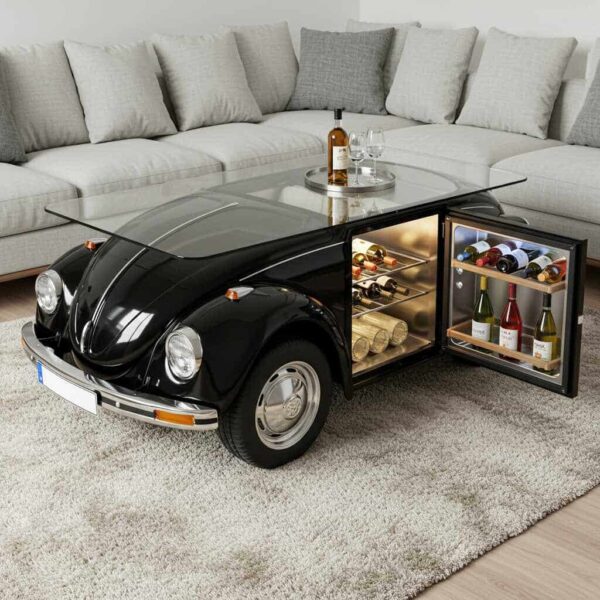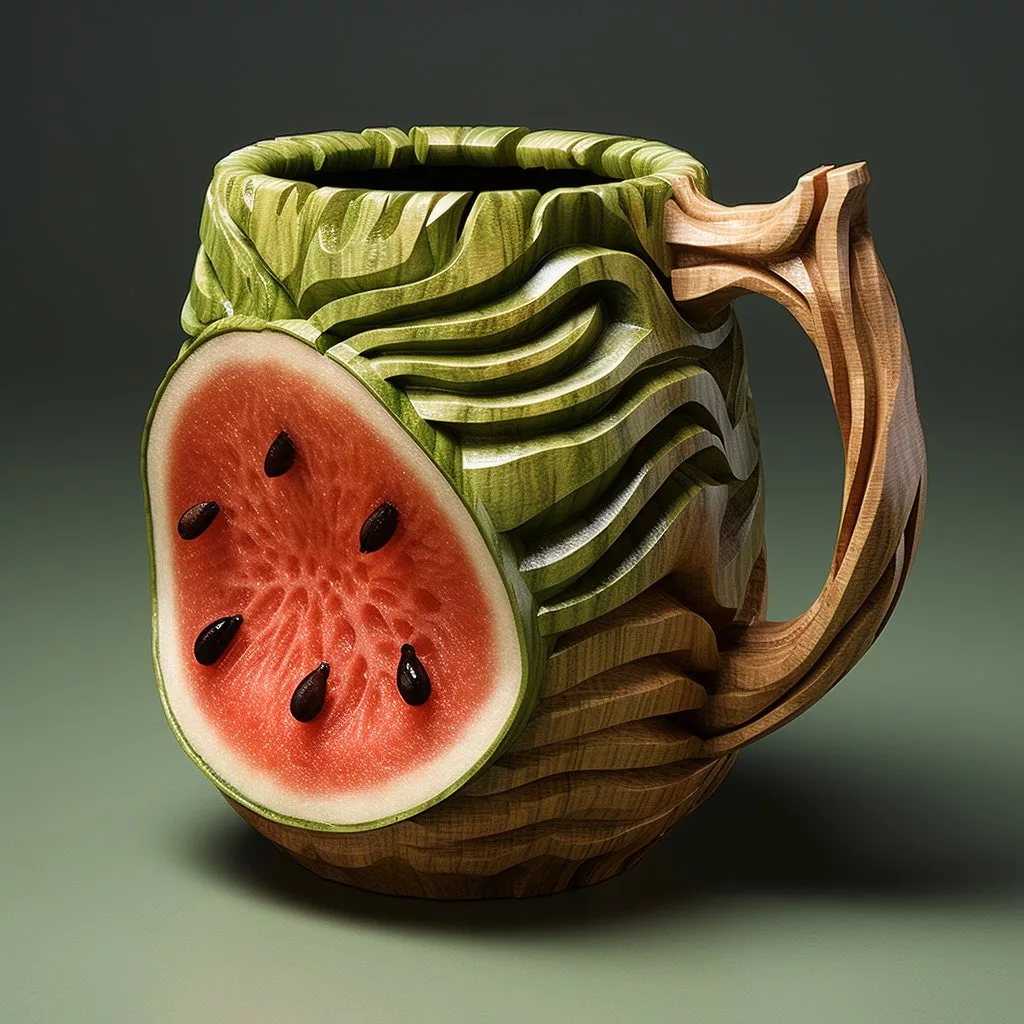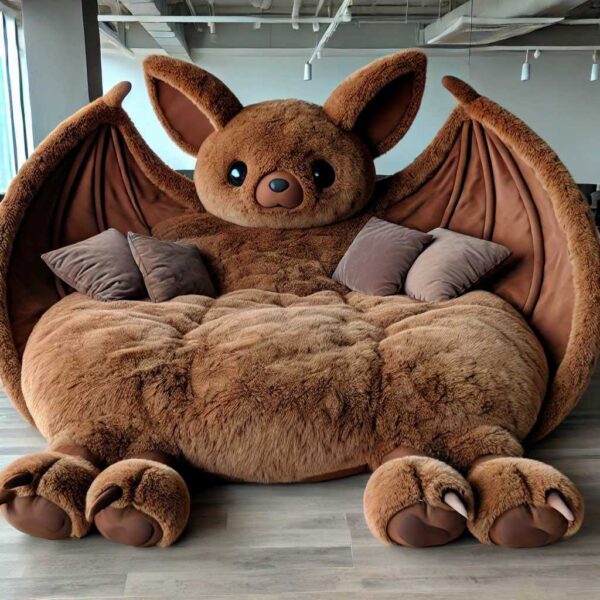The Volkswagen Beetle, a cultural icon that transcended its role as a mere automobile, has long captured the hearts and imaginations of enthusiasts worldwide. First introduced in 1938 under Adolf Hitler’s directive to create an affordable “people’s car,” the Beetle quickly evolved beyond its utilitarian origins to become a symbol of freedom, individuality, and counterculture movements throughout the twentieth century. Its distinctive rounded silhouette, affectionately dubbed the “Bug” by admirers, became instantly recognizable across generations and continents, making it one of the most beloved vehicles in automotive history.
What makes the Beetle’s legacy particularly remarkable is its ability to maintain relevance through decades of changing social landscapes and technological advancements. From its post-war resurgence as a symbol of hope and renewal in Europe to its embrace by the hippie movement in the United States during the 1960s and 70s, the Beetle consistently adapted to emerging cultural narratives while retaining its essential charm. This adaptability extended beyond its practical use as transportation; the Beetle’s form factor and emotional resonance inspired countless artistic interpretations and design innovations across various mediums.
In contemporary times, the Beetle’s influence has expanded beyond the automotive world into the realm of home decor and furniture design. This evolution represents more than just a nostalgic nod to automotive history—it signifies a sophisticated integration of industrial heritage with modern interior design principles. Among these creative reinterpretations, the Volkswagen Beetle Shaped Coffee Table stands out as a particularly compelling example of how automotive nostalgia can be thoughtfully incorporated into living spaces. These coffee tables capture the essence of the original vehicle’s aesthetic while serving a practical purpose in modern homes, effectively bridging the gap between automotive culture and interior design.
The Beetle’s enduring appeal lies in its unique combination of simplicity and character. Its minimalist yet expressive design language continues to inspire designers who seek to blend form and function in innovative ways. As we examine the emergence of Beetle-inspired furniture, particularly the coffee table variant, we witness how this iconic shape maintains its cultural significance while adapting to new contexts and purposes. This transformation from road-worthy vehicle to functional art piece demonstrates the Beetle’s remarkable ability to reinvent itself while preserving its core identity—a testament to its timeless design and cultural impact.
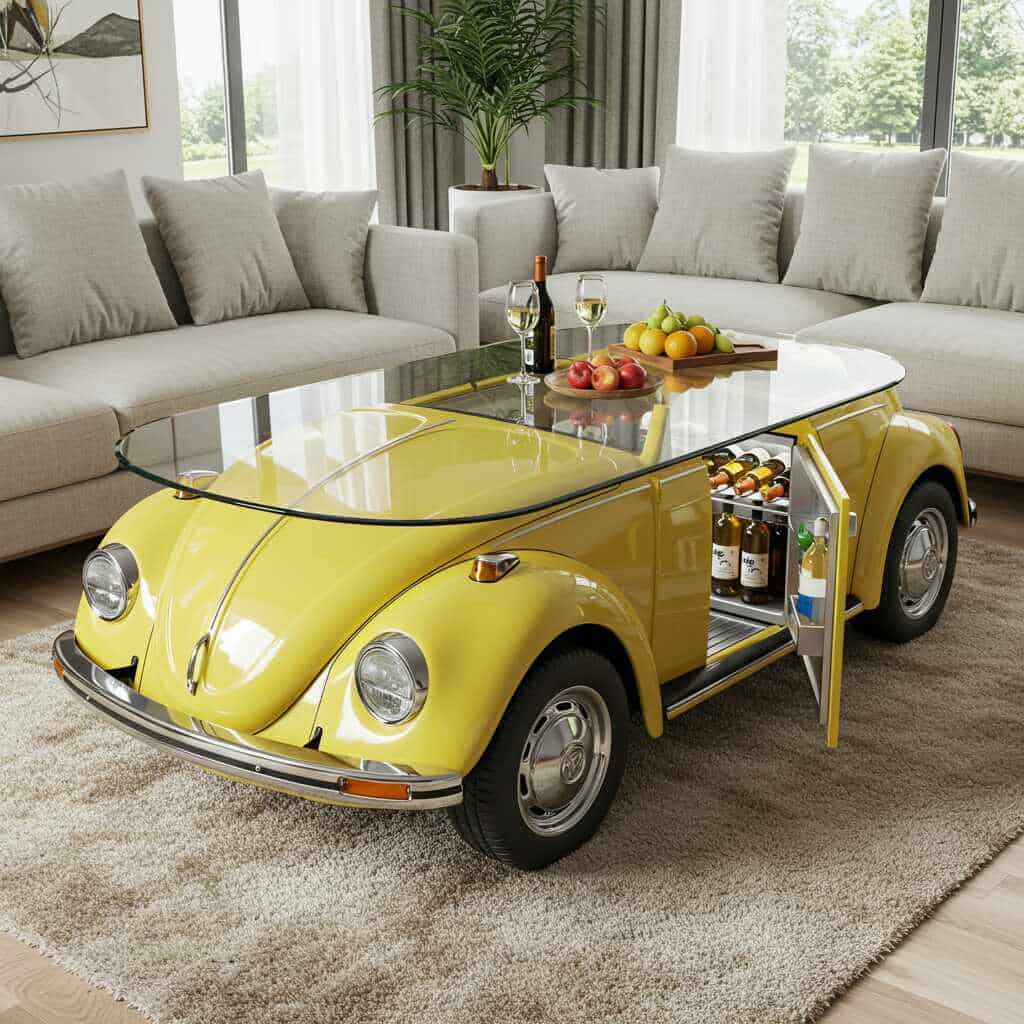
Contents
The Evolution of Automotive-Inspired Furniture
The intersection of automotive design and furniture creation represents a fascinating convergence of engineering precision and artistic expression. Historically, the relationship between automobiles and home furnishings began in the early 20th century when industrial materials and manufacturing techniques first crossed over from automotive factories to furniture workshops. This transition was particularly evident during the Art Deco period of the 1920s and 30s, when streamlined forms and chrome accents characteristic of luxury automobiles began appearing in high-end furniture designs. The Beetle-shaped coffee table emerges as a direct descendant of this tradition, carrying forward the legacy of integrating automotive elements into domestic spaces while adding its own unique twist.
Modern furniture designers have increasingly turned to automotive themes for inspiration, recognizing the inherent beauty in aerodynamic lines and meticulously crafted surfaces. Unlike traditional furniture pieces that often emphasize ornate detailing or rustic simplicity, automotive-inspired furniture celebrates the clean geometry and functional elegance found in vehicle design. The Volkswagen Beetle Shaped Coffee Table exemplifies this approach by capturing the organic curves and smooth transitions that made the original vehicle so endearing. Designers achieve this through careful attention to proportion and scale, ensuring that the table maintains the Beetle’s distinctive profile while functioning effectively within interior environments.
Technological advancements have played a crucial role in enabling designers to translate automotive aesthetics into furniture successfully. Computer-aided design (CAD) software allows for precise replication of complex curves and angles, while modern manufacturing techniques such as CNC machining and advanced composite materials make it possible to produce pieces that are both structurally sound and visually faithful to their automotive inspirations. These technological tools have transformed what might have once been purely conceptual designs into tangible, functional objects that bridge the gap between automotive heritage and contemporary living spaces.
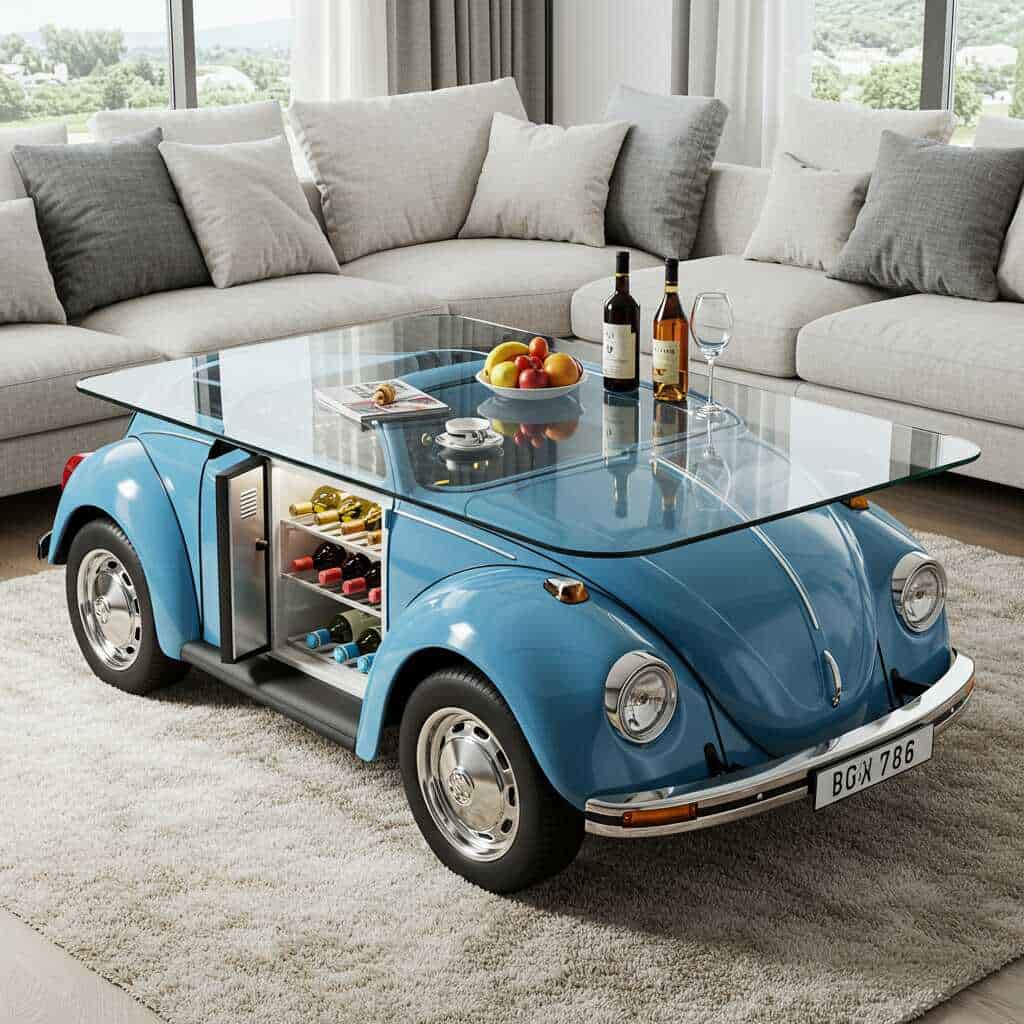
The Beetle-shaped coffee table stands apart from other automotive-inspired furniture pieces due to its unique combination of familiarity and innovation. While many automotive-themed furniture items focus on abstract interpretations or specific components like wheels or exhaust pipes, the Beetle table embraces the complete vehicle profile. This holistic approach creates an immediate emotional connection with viewers, tapping into collective memories of the iconic vehicle while presenting it in a completely new context. The table’s design typically incorporates key features such as the curved body line, rear engine compartment bulge, and circular headlight details, all scaled and adapted to serve practical functions as storage spaces or display areas.
Furthermore, the Beetle-shaped coffee table represents a sophisticated response to the growing demand for statement pieces that combine functionality with personality. In contrast to mass-produced furniture that often prioritizes utility over character, these tables offer homeowners an opportunity to express their appreciation for automotive design without sacrificing practicality. The design process involves careful consideration of how automotive elements can be reimagined to meet the needs of modern living spaces, resulting in pieces that feel both nostalgic and contemporary.
This evolution in automotive-inspired furniture reflects broader changes in how society interacts with design icons. Rather than simply preserving historical artifacts, designers are finding new ways to keep classic designs relevant and engaging for future generations. The Beetle-shaped coffee table embodies this approach by transforming a cultural icon into a functional object that serves as both a conversation starter and a practical addition to living spaces. Through this transformation, the table becomes more than just a piece of furniture—it becomes a bridge connecting different eras of design thinking and cultural appreciation.
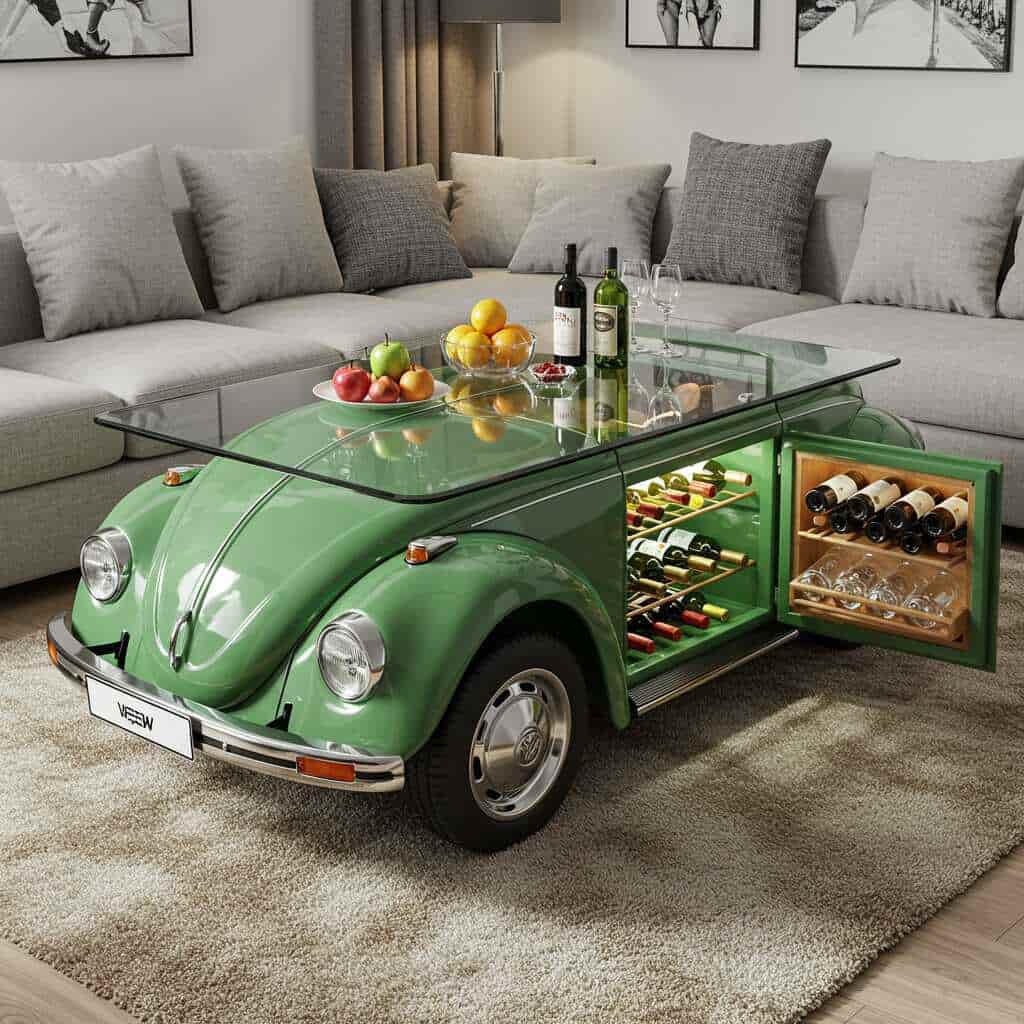
Design Elements and Construction Techniques
The Volkswagen Beetle Shaped Coffee Table represents a masterful fusion of traditional craftsmanship and cutting-edge technology, where each element contributes to its distinctive character while maintaining structural integrity. The table’s construction begins with its frame, typically crafted from aircraft-grade aluminum or high-density polyurethane foam, chosen for their exceptional strength-to-weight ratio and ability to maintain complex shapes. These materials provide the necessary foundation for replicating the Beetle’s iconic curves while ensuring stability and durability in everyday use. The choice of material extends beyond practical considerations, as each option offers unique aesthetic qualities—aluminum provides a sleek, industrial look, while polyurethane foam allows for more intricate detailing and smoother finishes.
Surface treatment plays a crucial role in achieving the authentic automotive appearance that defines these tables. Designers employ multi-layer finishing processes that mirror those used in automotive manufacturing, starting with a primer coat to ensure proper adhesion and surface preparation. This is followed by multiple layers of automotive-grade paint, which may include metallic flakes or pearlescent pigments to replicate the depth and luster of actual vehicle finishes. The painting process often concludes with a clear coat application, providing both protection and enhanced visual depth. Some premium versions incorporate custom airbrushing techniques to add subtle shading effects that accentuate the table’s contours, mimicking how light naturally interacts with the original vehicle’s surfaces.
Structural integrity receives particular attention in the table’s design, addressing challenges unique to its unconventional shape. Engineers implement internal reinforcement structures, often using honeycomb panels or tubular steel frameworks, strategically placed to distribute weight evenly while maintaining the table’s characteristic low-profile silhouette. These reinforcements are carefully integrated to avoid compromising the external aesthetic while ensuring the table can support typical loads expected of a coffee table. Additional stability comes from specially designed legs or supports that echo the Beetle’s wheel arches, creating a visual link to the original vehicle while providing practical support.

The table’s proportions undergo careful scaling to balance authenticity with functionality. Designers typically reduce the overall dimensions by approximately 60-70% compared to the original vehicle, ensuring the piece fits comfortably within standard living room configurations while retaining recognizable features. Critical measurements, such as the ratio between the front and rear sections and the curvature of the roofline, remain true to the original design’s proportions. This meticulous attention to scale ensures that even casual observers immediately recognize the table’s automotive heritage.
Functional elements integrate seamlessly into the design through clever reinterpretation of automotive components. The rear engine compartment, for instance, transforms into a hidden storage space accessible via a hinged lid mechanism that mimics the original vehicle’s decklid operation. Similarly, the headlight housings often incorporate LED lighting elements, providing ambient illumination while maintaining the table’s visual connection to its automotive roots. These functional adaptations extend to cable management solutions discreetly integrated into the table’s structure, acknowledging modern technological needs while preserving the piece’s aesthetic purity.
Material selection extends to secondary components as well, with glass tops often featuring anti-scratch coatings and tempered treatments for safety. Some designs incorporate genuine automotive parts, such as working turn signals or license plate holders, adding authentic touches that enhance the table’s automotive character. These elements require specialized wiring and electronic components, carefully concealed within the table’s structure to maintain its clean lines and prevent visual clutter.
The finishing process includes weatherproofing treatments similar to those used in automotive applications, ensuring the table’s longevity in various indoor environments. UV-resistant coatings protect against fading, while moisture barriers prevent warping or damage from spills—considerations that reflect both automotive engineering principles and furniture durability requirements. The result is a piece that not only captures the spirit of the original Beetle but also meets the practical demands of modern living spaces.
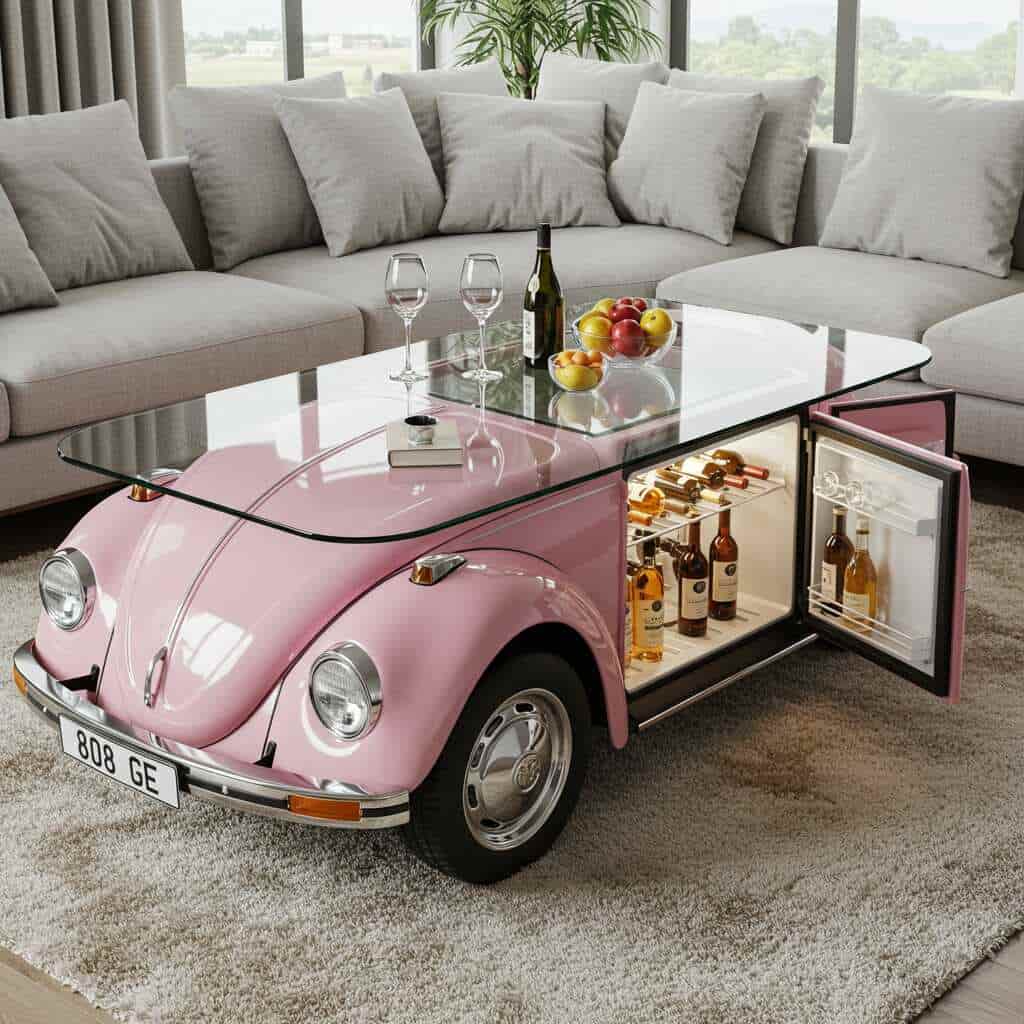
Nostalgia Meets Modern Living: Emotional Resonance and Practical Integration
The Volkswagen Beetle Shaped Coffee Table transcends its physical form to become a conduit of shared memories and cultural significance, seamlessly integrating into contemporary living spaces while maintaining its emotional impact. For many, the sight of this distinctive piece evokes a cascade of personal recollections—the childhood family road trip in a trusted Beetle, the college years spent restoring a vintage model, or the simple joy of spotting one on city streets. These associations transform the table from a mere piece of furniture into a repository of lived experiences, creating an emotional anchor that connects past and present within the home environment.
In modern interiors, the table serves as a focal point that bridges generational divides and sparks meaningful conversations. Its presence in a living room or entertainment area naturally draws people together, much like the original vehicle did during its heyday. The table’s familiar silhouette acts as a universal language, speaking to both older generations who experienced the Beetle’s golden era and younger audiences who appreciate its retro appeal. This cross-generational resonance manifests in spontaneous story-sharing sessions, where family members and guests exchange anecdotes about their own Beetle encounters or speculate about the adventures the original vehicle might have undertaken.
The table’s design cleverly incorporates elements that facilitate interaction and social connection. The curved surfaces invite touch and exploration, while the integrated storage compartments encourage discovery and engagement. These features transform mundane activities—storing remote controls, displaying decorative items, or setting down drinks—into moments of tactile pleasure and shared experience. The table’s ability to accommodate modern lifestyles while honoring its automotive heritage creates a unique atmosphere where nostalgia and contemporary living coexist harmoniously.
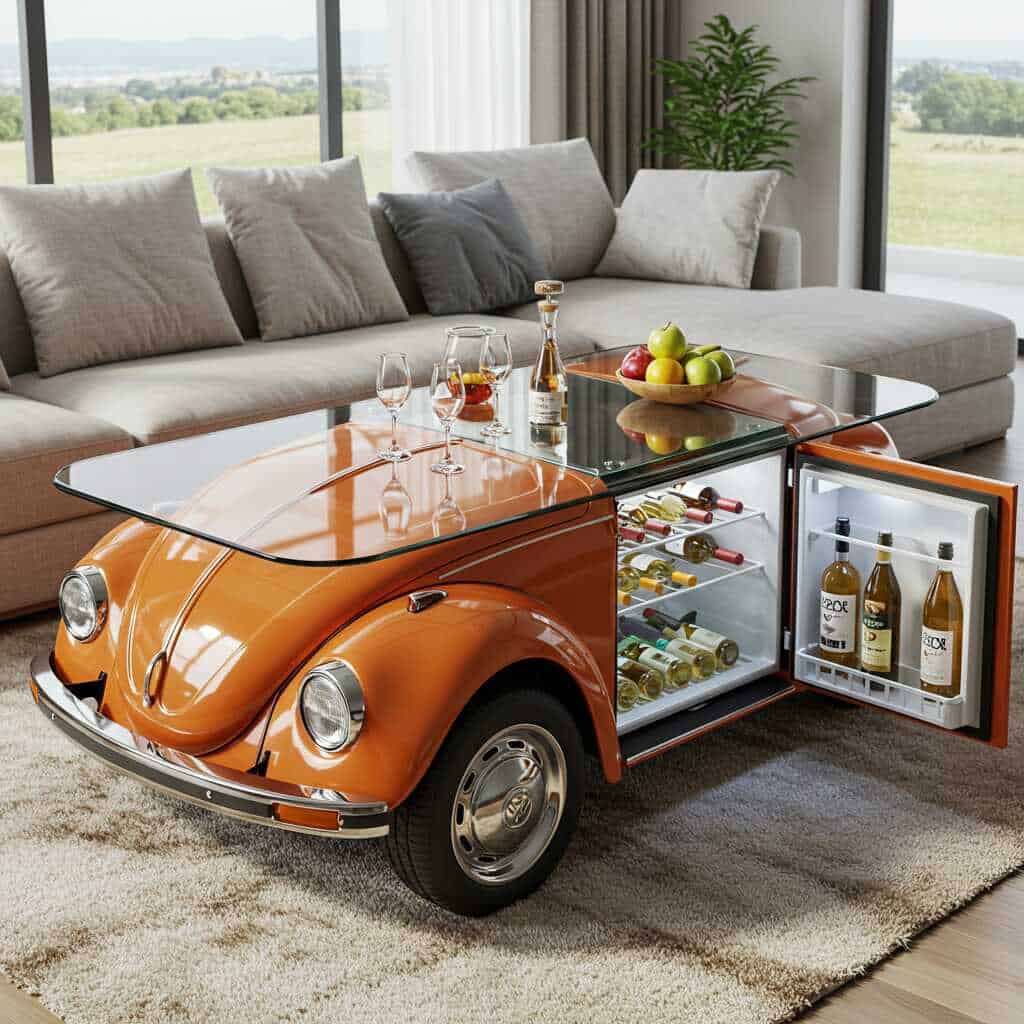
Lighting plays a crucial role in enhancing the table’s emotional impact within interior spaces. Many designs incorporate subtle illumination features that mimic the warm glow of vintage headlights, casting gentle pools of light that evoke evening drives along coastal roads. This thoughtful integration of lighting not only serves practical purposes but also creates an ambiance reminiscent of the romanticized road trips associated with the original Beetle. The interplay of light and shadow across the table’s curved surfaces further emphasizes its sculptural quality, transforming it into a dynamic element that responds to different times of day and varying natural light conditions.
The table’s placement within a room significantly influences its ability to foster connections and trigger memories. When positioned centrally, it becomes more than just a surface for coffee cups—it transforms into a gathering point that naturally encourages face-to-face interaction. Its distinctive shape breaks the monotony of conventional furniture arrangements, creating visual interest while inviting people to move around and engage with it from multiple perspectives. This mobility mirrors the freedom of movement associated with driving, subtly reinforcing the table’s automotive heritage through spatial dynamics.
Moreover, the table’s presence can influence the surrounding decor and overall atmosphere of a space. Its organic curves and nostalgic appeal often inspire complementary design choices, such as mid-century modern seating or vintage automotive memorabilia displays. This ripple effect extends the table’s influence beyond its immediate physical boundaries, shaping the entire room’s character and encouraging occupants to curate spaces that reflect their personal histories and aesthetic preferences. The result is a living environment that feels both personally significant and universally appealing, where the past informs the present without overshadowing it.
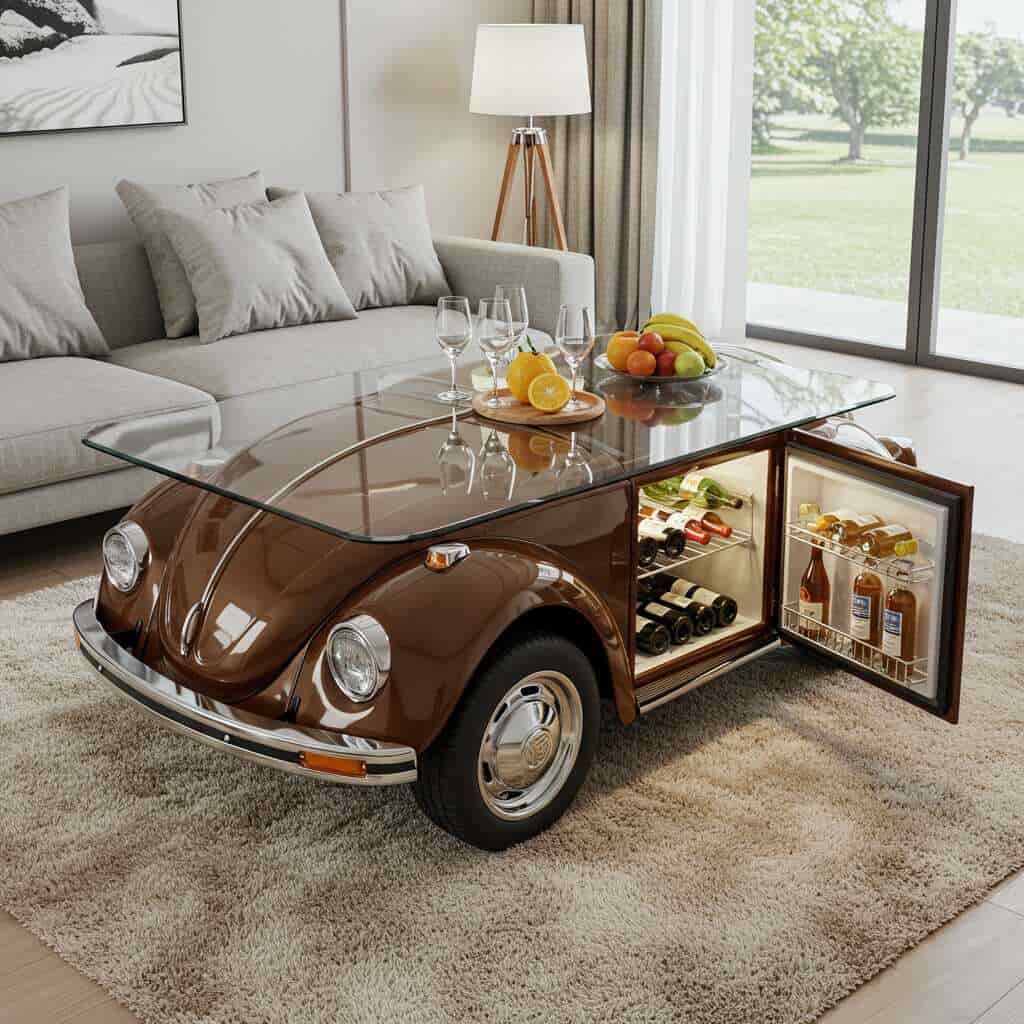
Conclusion: A Timeless Fusion of Heritage and Innovation
The Volkswagen Beetle Shaped Coffee Table stands as a remarkable testament to the power of design to transcend its original purpose and find new meaning in unexpected contexts. This innovative piece of furniture represents far more than a mere homage to automotive history; it embodies a sophisticated synthesis of nostalgia and modern design sensibilities. By preserving the essential character of the original Beetle while adapting its form to contemporary living needs, the table achieves a delicate balance between honoring the past and embracing the present. Its success lies in its ability to maintain the Beetle’s distinctive personality while serving practical functions within modern interiors, demonstrating how iconic design can evolve without losing its soul.
The table’s impact extends beyond its physical presence, serving as a bridge between different eras of design philosophy and cultural appreciation. It challenges conventional notions of what furniture can represent, transforming a functional object into a vessel for shared memories and emotional connections. Through its careful integration of automotive elements with modern construction techniques, the table showcases how industrial heritage can inform contemporary design without feeling dated or out of place. This seamless fusion of old and new creates a piece that feels both familiar and fresh, capable of resonating with diverse audiences across generations.
As we consider the broader implications of this design approach, it becomes clear that the Volkswagen Beetle Shaped Coffee Table represents a larger trend in how society engages with design icons. Rather than preserving historical artifacts in their original form, designers are finding innovative ways to keep classic designs relevant and engaging for future generations. This approach acknowledges that true design excellence lies not in static preservation but in dynamic adaptation—maintaining core values while responding to evolving needs and contexts. The Beetle-shaped coffee table exemplifies this principle beautifully, proving that even the most beloved forms can find new life when approached with creativity and respect for their heritage.
Ultimately, the success of the Volkswagen Beetle Shaped Coffee Table lies in its ability to speak to something fundamental about human nature—the desire to connect with our past while moving forward into the future. It reminds us that great design, whether in automotive or furniture form, possesses an inherent timelessness that transcends its original purpose. By bringing the spirit of the Beetle into our living spaces in a way that feels both authentic and contemporary, this remarkable piece of furniture demonstrates how nostalgia and innovation can work in harmony to create something truly special—a design that honors its roots while planting seeds for future inspiration.

